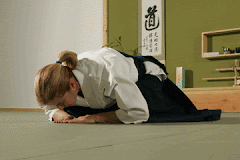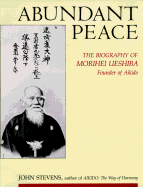The ever-changing world is around us, despite our perception of it — it just is. Often we are amazed by something that occurs right in front of our eyes, simply staring back at our amazement - just being there.
Today was my first day at the Dojo, after four days trip to the breathtaking Lake Tahoe in Northern California. As I was filling more water into the Dojo's small fountain, I saw this baby sunflower that sprouted in between the rocks. I was standing there for some time, staring at it in wonder - just perfect...
The key to the mystery is that we also have some canary birds at the Dojo, as well as their food, which includes sunflower seeds. They tend to be somewhat messy, and seeds get spread around the Dojo. One of them found transformation...
Sunflower baby,
showing green.
Teaching life.
Monday, September 22, 2008
Friday, September 12, 2008
The weakness within the strength

A few days ago, at our Aikido adults class, something caught my eye. At one point, it was very clear that almost every one of the students were using their main strength; the physically strong were very forceful, the strong-willed were stubborn, the agile were moving way too fast, and the heady were thinking a lot. I thought it was interesting to see how we choose to use what we feel we are good at, as much and frequent as possible.
I noticed that none of this was working very well. Almost all the students were overdoing it and faced difficulty in their practice; there was a lack of connection, sloppiness, or just a poor application of techniques.
What we consider ourselves to be good at may be misleading. Is our strength really a strength, or is it also a weakness? Obviously, we need to use some judgment about when, with whom, and to what extent we utilize our natural tendencies. Let's take the agile person, for example: if he is going too fast, working with a slower partner, there will be lack of connection. An agile person, who is slowing down and working on controlling his speed, is actually practicing "out of the box". Working only within the talent's limits keeps us in our comfort zone. Trusting our strengths alone may be a curse. Navigating into what we consider to be "a weakness" may unravel some great discoveries about who we really are.
We should acknowledge the strengths we were blessed with, yet remember that other blessings may be found on the other side as well.
Wednesday, September 10, 2008
Balance in practice

Our practice may shape our life, and our life sometimes dictates how we practice.
Some Aikido students, usually younger, who are Uchi Deshi (内弟子:うちでし, live in apprentices), often practice 3-5 hours daily. On my visit to Hombu Dojo (Aikido World Headquarters) in Tokyo, I saw a big group of older people showing up, every morning of the week, to the 6:30 am class with Dōshu (道主, Master of the Way). I met students who used to practice everyday, and due to life changes, only get to practice once a week. I know of many people who choose to train once, twice, or three times a week. So, what is the right amount for practice?
Many teachers, including my teacher, say that Aikido should be a daily practice. Some students say they feel burnt out when practicing daily. Each practitioner walks his/her own path. In O'Sensei's rules of practice, he says: "In daily practice first begin by moving your body and then progress to more intensive practice. Never force anything unnaturally or unreasonably. If this rule is followed, then even elderly people will not hurt themselves and they can train in a pleasant and joyful atmosphere." So, the balance is not just found in the "how much" but in "how" as well.
Practice is "a way of life", and should be an integral part of one's usual routine, whether one chooses to train daily or otherwise, consistency should be kept. This way the practice will ingrain as a discipline. Both the time and the effort invested will determine the rhythm of the study. Our attitude, as well as our "hunger to learn", or lack thereof, may quicken or slow down the pace. On the mat, we practice in accord to our physical condition and ability. We push ourselves, yet we have to remember we are here to polish our spirit as well.
The secret of making the best out of our training may be found in balancing the "how" and "how much", as well as making sure that the practice is harmonizing with the rest of the pieces of our life's mobile.
, Dōs
Saturday, September 6, 2008
Finding the balance

About a month ago, I wrote a post about the act of dynamic balancing. I believe that before we start maintaining balance, we actually need to create a balance. Creating a life balance entails making choices about the ingredients we will use in our moment-to-moment balancing.
A good place to start is an examination of the different areas of life. Then, we can start allocating the portions that each area fulfills. Here is a suggested list:
- Career/Work - For most of us, this is our means of living, whether we love it or not, the fruits of this work sustain us. Since it has the most immediate and tangible results, we sometimes are tempted to give it the biggest portion.
- Friends & family - Our family and friends can be a great source of comfort and connection, as well being supportive through difficult times. We should be careful not to take them for granted.
- Community - The larger scale of giving and sharing comes to play here, whether helping someone across the street, or doing some volunteering work.
- Self development - This is where we invest in ourselves. The investment may be on an intellectual level, creative side, through hobbies, practices and study. This is the area that is dedicated to our internal self growth.
- Health - In this area we pay attention to what we eat, drink and take in, through our five senses. We become aware to what creates the most positive settings for our mental and physical health, and what should be given up, when it not in contribution to our well being.
- Spirituality - On the more subtle levels, this is where our vision and our outlook stems from. Whether the framework is praying in a congregation, or a solo meditation - we find our inner power and connection in these spaces.
- Doing nothing - Lastly, each of us needs time alone, as I mentioned in my last post about Aloneness. This is when we recharge and connect with ourselves, and our purpose. Spending time alone helps us re-enter the world feeling refreshed and connected. This is our "Off time", or the way the Italians call it: "Il Dolce Far Niente" ("sweetness of doing nothing"). This is truly an art, and here are a couples of ways to do it: First, finding a place to relax in. Disconnecting all distractions (cell, computer, PDA and such). Eyes closed. Breathing. Or, simply enjoying a cup of hot chocolate, tasting fresh bread, or sipping soup on a Winter day. If outside in nature, just looking around, listening, smelling and touching. Feeling the wind, the sun, or the rain drops.
This is a partial list for some people, for others it contains too many areas. Choose for yourself; what time will be dedicated to each domain, and go ahead and commit to it. Trying it for a few weeks will provide a good idea of how much balancing is needed in order to keep a commitment to your life of choice. After a while, make your tweaks and adjustments - and as you do the balancing act, remember: Consistency is your friend...
Labels:
balance,
balancing,
consistency
Aloneness
 I love people. I love my family, my children . . . but inside myself is a place where I live all alone and that's where you renew your springs that never dry up.
I love people. I love my family, my children . . . but inside myself is a place where I live all alone and that's where you renew your springs that never dry up. ~Pearl S. Buck
My daughter, Aria (6), is an only child. She gets to play alone quite often. This play time is called "Quiet Time" - either in her room or in the backyard, she plays alone, quietly and joyfully. When I asked her to describe what Quiet Time is, she said: "Quiet Time is a time I get really creative. When I am alone I feel joy inside my heart. I can get deeper into it, especially when I concentrate, I can invent new stories, and go into my magical worlds. Quiet time is very nice, I feel the lioness inside me, and I think about great things. In my quiet time outside, in the yard, I look for things I've never seen before..."
In the peacefulness of the state of aloneness we are fully connected to the "bigger picture", or God, or nature. We feel secure, thankful and content. On the other hand - in our society it is common to find that the TV in always on, whether we watch it or not, the radio is always on while we drive, and we surround ourselves with noise, news, and an ongoing stream of information. We must be entertained by sounds, sights, stories and dramas. We keep running away from being by ourselves. The fear of our unraveling ego, or facing our true self, is causing us to escape from "looking in the mirror".
The Indian mystic, Osho, said "the first thing is to acknowledge aloneness. Aloneness is our true nature; we can never, ever, not be alone. We come into this world alone, we leave the world alone. And in between these two, we are alone – but we frantically hide from it, run from it, pretend it isn’t true."
The knowing rooted in aloneness allows us to get closer to ourselves, appreciate what we have, and helps us connect better to nature, our loved ones, and our surroundings. Having some time of solitude brings a great appreciation to the life we live. Choosing moments of aloneness, whether taking a walk, in Seiza on the mat, or in meditation, is truly beneficial. Watching the clouds, humming a little tune, smelling flowers, or enjoying a private dance at home, can easily fill the daily dose of aloneness in our commitment to ourselves.
Labels:
aloneness,
quiet time
Monday, September 1, 2008
More on Mushin: double attention

Part of capturing the flowing feeling of Mushin (no-mindedness, or empty mind) is having double attention. Instead of being fixated on what is outside of ourselves, we keep mindful - through our mindfulness we are not detached from what is around us. We take integral part in our reality, the hear-now. We focus on what is around us, as well as on our own physical, mental and emotional experience.
In this short video, James Traitz, author of Don't Stop Your Mind, encapsulates the practice methods and the experience of Mushin.
Self remembering is a excellent way for a daily practice. Beside generating awareness, it brings about many other important lessons, such as humility, compassion, and clarity. We learn our part in the ever-changing cosmic web, on which we are all interconnected. It is a way to deeply examine our behavior and habits, and watch when we are "on automatic". This is a tool that sharpens our ability to create change, fills us with courage, and helps us to face our fears. The practice being fully present in the moment enables us to live a fuller, more enjoyable life.
Labels:
double attention,
mindfulness,
Mushin,
self remembering
Subscribe to:
Posts (Atom)















